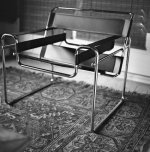The Fujis are all quite a bit bigger than the older 6x6 folders.
On the Super Ikonta front, the Super Ikonta III is probably the smallest. These come with the f3.5 Tessar or Novar - don't dismiss the latter, it is still quite good, and somewhat cheaper. Do read some of the threads here about film spacing - it is not so much a defect as a product of modern, thinner films/backing paper. You can easily work around this. If you want an f2.8 lens, you'll need to go with the older type bodies with the sliding prism rangefinder. These are quite a bit heaver, but are well made.
If you are after a faster Tessar (f2.8), you might want to look at the Certo Six. You do need to make sure the RF is good - the RF mirror often degrades, but it isn't that hard to fix. The camera is (IMHO) better made than the Super Ikonta, with a better unit-focus lens and a more handy 40.5mm filter thread. The lens standard is very rigid, and incorporates parallax correction. The viewfinder is not quite as good, and the focus lever is not to everyone's taste.
The Mamiya Six folders, especially those with the later lenses (like the Zuiko) are worth a look too. Very rigid, with the film plane moving to focus while the lens is fixed. Good viewfinders, and a nice little flag that drops into the viewfinder after you've taken a shot.
A rarer sight in the west is the Super Fujica-6 folder. Lighter in weight than the other cameras mentioned, but it seems rigid enough, with a good lens and an excellent viewfinder.
My favourite 6x6 folder though remains the Iskra. The best viewfinder I've come across in a folder, with an excellent lens. Their weak spot is the film advance mechanism (just like on the Agfa Super Isolette), so get assurances from the seller that it is in proper working order. If I were to keep one folder, this would be it.
Hope this helps.


